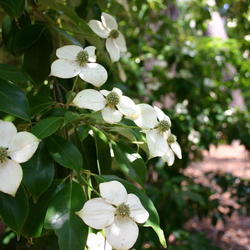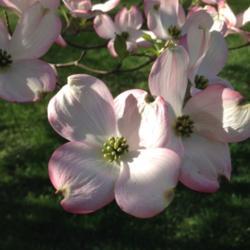The American or Eastern Flowering Dogwood is a well-known and glorious ornamental tree that is native to southern New England, lower New York, through the southeast tip of Ontario, half of lower Michigan, Indiana into the southern half of Illinois, to eastern Oklahoma and eastern Texas to northern Florida, back up to New England, growing wild on the edges and within of upland forests. It grows about 1 to 1.5 feet/year and lives about 100 to 150 years. The tree has a wonderful horizontal, tiered, wishbone branching habit with the branchlet tips turned upward. Its bark is gray-brown and goes from being smooth when young to scaly to blocky. The opposite, simple leaves are 3 to 6 inches long by 1.5 to 2 inches wide with a pointed apex. The foliage turns a good orange-red to scarlet in the fall. The true flowers are small, greenish-yellow in compact heads in the middle, surrounded by 4 large white bracts, occasionally pink or rose, where these flowering bracts are rounded on the ends with a small notch at the end, and bloom in late April to early May before the leaves emerge. The fruits are small, bright red drupes to 1/2 inch long, in clusters, and are of high food value to birds and some mammals; not edible for humans. The root pattern is deep, coarse, lateral but the plant can be dug and moved in early spring. This is a very popular ornamental tree sold at most any nursery in or around its native range. In my native Chicago, IL, area this species often has not thrived because the soil needs to be more acid. However, I have seen some nice trees occasionally in part-shade and good quality soil recently in the region. In the 1990's a Discula canker & leaf blight fungus disease from east Asia was introduced into the eastern US and a good number of trees died or were damaged. This freaked everybody out, and the Kousa Dogwood from east Asia was planted a lot instead. Fortunately, since after the turn of the century past 2000, I still see a large number of Eastern Flowering Dogwoods doing well in southeast Pennsylvania in landscapes and some wild in the woods.

What is good about the Kousa Dogwood tree that is native to China, Japan, and Korea is that it has pretty, mottled, smooth bark; good red fall color; and pretty, white flowers with sharp-pointed petals that appear with the leaves in late May and June. What is bad about this species is that it bears lots of the large, soft, red, multiple-drupe fruits that make quite a mess on lawn or especially on paved surfaces. The only animal that I've seen feeding on the fruits, as they are rotting, are Yellowjackets. One woman told me she thought her squirrels ate some. The stiff branching habit of this bushy small tree is not nearly as nice as the sort of roller coaster branching of the American flowering Dogwood. This is commonly planted in the Mid-Atlantic and Northeast US. I've seen only a few specimens in the Chicago, IL area. There are several cultivars commonly available also.

According to "How to Know the Wildflowers" (1922) by Mrs. William Starr Dana, this plant flowers in June with bright red berries appearing in late summer. Though, she notes that it sometimes flowers into late summer, as well. According to her book, Bunchberry is called the "plant of gluttony" in the Scotch Highlands on account of its supposed power of increasing the appetite. She also notes that it is said to form part of the winter diet of the Eskimo.

This Redosier Dogwood is a northern species that grows way up north into most of Canada, the Pacific Northwest, the Rocky mountains, the northern Plains, all Minnesota & Wisconsin & Michigan, northern and central Illinois, Indiana, and Ohio, areas of West Virginia & Pennsylvania, New Jersey, New York, and New England in bogs, swamps, bottomlands, and along lakes and watercourses. Its most popular characteristic is that the stems turn bright red in late fall-winter- early spring. It bears creamy, 2 inch wide flower clusters in late May and early June that develop to clusters of white berries in August-September that are loved by many birds. It develops a good red fall color. it is fast growing and easy to transplant or move bare root. It is a well-known shrub that is offered by most all nurseries and is common in people's yards and in landscapes by landscape designers. This species should not be placed on hills or berms where the soil gets dry as it can not stand drought. It needs full sun as best so it will be less likely to suffer from leaf spots and stems cankers caused by fungi. It must be pruned by cutting larger stems to the ground when they start turning gray-brown and leaving some smaller stems to replace them. Never shear as a hedge as stem canker will be bad. I have seen deer feed on this species. The Siberian Redtwig Dogwood is very similar and is also sold a lot, and the only way to tell them apart is that this Redosier is sort of stoloniferous by sending out stems along the ground and this native species has the stone or seed in the fruit as being broad as high or slightly broader, rounded at base; while the Asian species has the seed higher than broad and flattened at each end.

Pink Flowering Dogwood (Cornus florida f. rubra) is a multiseason ornamental native tree. In the spring, it delights with vivid pink blossoms, followed by round red berries in the late summer, which are enjoyed by birds. In the autumn, the leaves turn a deep red.

The fruit fully ripens only after it falls from the tree. When ripe, the fruit is dark ruby red or a bright yellow. It has an acidic flavour which is best described as a mixture of cranberry and sour cherry; it is mainly used for making jam, makes an excellent sauce similar to cranberry sauce when pitted and then boiled with sugar and orange, but also can be eaten dried. (Wikipedia)

I remember a landscaper from McKay Nursery in southern Wisconsin who would plant a Pagoda Dogwood to the side of each house in the front yard as his signature in Wisconsin and northern Illinois. This species is a really beautiful tree that is clean and neat with a number of good characteristics all year long: pretty foliage, nice flowers, good red fall color, smooth bark, and a great form with its wide, horizontal, tiered, wishbone branching. Its native range is from Nova Scotia down to north Georgia to Missouri up to northern Minnesota in upland forest. It is offered by a good number of conventional and native nurseries. It is not well-known by the general public, but it is cherished by professional landscape architects and designers. It needs good quality soil that is moist, slightly acid to slightly alkaline. It does best with shelter from hot, dry strong winds and it does not do well with strong drought. It should be used more than it is.

This 'Elegantissima' Redtwig Dogwood has been a popular cultivar of the Siberian Redtwig Dogwood with its light green leaves that have a creamy-white edging, and has been a commonly sold plant from conventional nurseries in the Midwest, the Mid-Atlantic, and Northeast US since at least the 1970's. Its cultivar name also is 'Argenteo-marginata.' It does not grow as big as the regular mother type and its twigs and stems are more slender also. It can be hit lightly or heavily by leaf spot disease or twig canker disease some years. There is also a very similar cultivar just called 'Variegata' that has darker green in the leaves and is more vigorous growing, and can be mixed up in the trade with this specific cultivar.

This nice mutation of the Redosier Dogwood is planted occasionally in yards and landscapes in the Midwest, Mid-Atlantic, and Northeast of the US. This cultivar is sold by a good number of nurseries. It was first discovered at the Arnold Arboretum in Boston, MA, a good number of years ago. Like the regular Redosier Dogwood or the Siberian Redtwig Dogwood, it should not be planted in hills or berms where the soil gets dry, as it gets stressed by drought. It does best in full sun and wet draining soil, as near ponds or creeks. It should not be sheared because that helps cause any bark canker disease to increase. The Yellow-twig Dogwood does suffer some black canker marks on the smooth stems, and the leaves often get some leaf spot disease showing up later in summer. Old stems get big and brown-gray and should be pruned away at the ground level to keep the shrub having its handsome yellow twigs in the winter. In summer the stems turn mostly green and don't show up. It does bear the nice round clusters of white drupes (fruit-berries) in late summer and early fall that are edible by birds.

I used to sell some Gray Dogwoods at a conventional nursery in northeast Illinois to be used as a screen or in a shrub borders to some customers. In landscapes it is usually about 8 to 12 feet high and wide. It gets bigger in nature and suckers a lot to form a colony. It is native from central Maine to northern Delaware, most of New York and Pennsylvania, areas of West Virginia, lower Michigan, Ohio, Indiana, Illinois, Wisconsin, parts of Missouri, much of Iowa & Minnesota, and southeast Ontario, growing in upland sites of meadows, prairies, forest edges, hilltops, and cliffs. Smooth twigs are tan to red-brown, pith white to brown, and stems with smooth, gray bark. The creamy flower clusters to around 2 inches wide bloom in late May to early June. The white fruit is borne in August-September and is loved by over 100 species of birds. After the fruit is gone, the red peduncle stems that held the fruit are attractive. Shallow, fibrous roots makes it easy to transplant. Grows about 1.5 feet/year overall. It is found only rarely or occasionally planted in yards. It is more likely to be used by landscape architects that know this good shrub at parks, public properties, campuses, etc.
